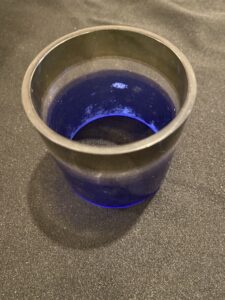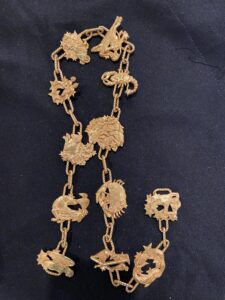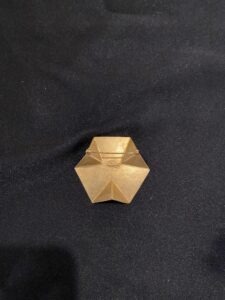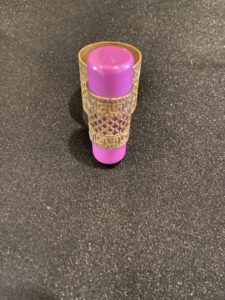Episode 192
What you’ll learn in this episode:
- Who jewelry designer Bill Smith was, and why his work and life deserve to be remembered.
- Why Bill Smith was a trailblazer for Black jewelry designers.
- How JoAnne tracked down long-forgotten jewelry to create the exhibit “Bill Smith: Madison’s Visionary Jewelry Designer.”
- Why Bill Smith’s body jewelry was ahead of its time.
- How jewelry trends trickle down from high jewelry to costume.
About JoAnne Spiller
JoAnne Spiller is the Director of Education at the Jefferson County Historical Society based in Madison, Indiana. She has more than two decades of museum education experience with an emphasis on children’s educational programming. She recently organized the exhibit “Bill Smith: Madison’s Visionary Jewelry Designer,” and is currently conducting research for a book on Bill Smith’s life and career.
Additional Resources:
Photos:
lucite cuff

Zodiac belt for Richelieu

Smith-St. Jacques brooch back

Smith-St. Jacques brooch front

Ring

Transcript:
Bill Smith was a trendsetting Black jewelry designer who did everything from Cartier collaborations to costume jewelry. His designs were seen on the likes of Lena Horne and Cicely Tyson. Yet in the 30 years since his death, his impact has been largely forgotten. JoAnne Spinner, Director of Education for the Jefferson County Historical Society, hopes to change that with her recent exhibit, “Bill Smith: Madison’s Visionary Jewelry Designer” and a forthcoming book she is currently researching. She joined the Jewelry Journey Podcast to talk about Bill’s trendsetting designs; how he found his path as a gay Black man from a small town; and why his work is worth collecting. Read the episode transcript here.
Sharon: Hello, everyone. Welcome to the Jewelry Journey Podcast. This is the second part of a two-part episode. If you haven’t heard part one, please head to TheJewelryJourney.com.
Today, we’re talking with JoAnne Spiller, the Director of Education for the Jefferson County Historical Society located in Madison, Indiana. She recently curated an exhibition about Bill Smith who came from Madison, Indiana. Welcome back.
Tell us a little bit more about the body jewelry. You mentioned that and we haven’t really talked about it.
JoAnne: Oh, the body jewelry! He designed clothes made of, say, pearls or metal chain or gold-colored coins, fake coins; halters and skirts and crazy little headpieces, collars. The body jewelry really set him apart. Barbara Walters interviewed him and had a runway show with his body jewelry. I’d love to have a clip of that, at least to look at it and hear Bill’s voice because I don’t know what he sounds like. His body jewelry put him on the scene. It was crazy, and it was meant to be worn over clothing. Some of it was skimpy clothing; it just depended on the runway and where they were having their show. If it was a lady’s luncheon, then they were wearing leggings and turtlenecks underneath, but some of the actual fashion shows were a little more risqué. That was the timeframe. Everything was loosening up as far as dress code, I suppose, but it was out there, and it went crazy.
Richelieu thought it was gimmicky, but Bill pressured them into manufacturing some of them. They were all done by hand and sent to high-end department stores for display to catch your eye when you walked by. Who was really going to wear a garment made of giant pearls? People ate it up. They loved it. Pretty soon, they were having orders that were hard to keep up with, according to Clifton, and all the fashionistas were wearing it. I have an article that states that even brides were excited about wearing his pearl jewelry. I would love to get a hands-on look at someone wearing pearl jewelry for a wedding. That’s got to be out there.
That was his big start, just big, bold, in-your-face, why-would-you-ever-wear-that jewelry. It’s very experimental. Some of the chains were heavy. To wear a halter or a cape or a skirt made of that must have been uncomfortable. Some of his pearl scarves are six feet long. I can’t imagine carrying that weight around.
I did a reproduction of one of his pearl dresses for my exhibit. I called her Pearl. My boss put her on a Christmas tree stand and she actually twirls, so you can see the movement in the garment. It’s on just a plain mannequin. It took me probably 15 hours to make it. I did the halter. I did the whole thing. It’s the showstopper, but it is the only way we will ever have that kind of garment in our collection. We can’t afford it. We’re small. We’re so small. We would love to have one, but it’s just out of our reach. So, for $53 for the design, I made Pearl. She twirls, and she’s wonderful.
Sharon: Those were on Vogue covers, weren’t they?
JoAnne: Absolutely. High society ladies were wearing them because it was so—I don’t want to say obnoxious. It was one of those things where it was in your face. I don’t know how you sat in it, but they would wear them.
Sharon: The literature I was reading said he designed for Naomi Sims and Lena Horne and a lot of other well-known people. Do you think it’s stashed in a drawer? They don’t have any idea whose it is?
JoAnne: I’m going to guess yes. He and Naomi were very good friends. There’s a magazine spread that shows the two of them, and she’s wearing the cuffs he designed for Cartier. That’s another example of the high-end stuff, these cuffs, but I haven’t seen them in a while. He did the covering for her hair for her personally. That was her own item. I know Lena Horne wore his things, and Cicely Tyson and Loretta Young wore them on her TV show.
When I have time, I go through photo archives just hoping to find something I can attribute to him, someone wearing that. Not a whole lot of luck right now. Naomi Sims has passed away. I believe Cicely Tyson and Loretta Young are no longer with us. The field of people who may have his jewelry is very small, at least the people I know about, and it’s hard trying to find that connection, as if maybe they do have a piece I can at least look at. I don’t need to have it per se, but I sure would like to see it and photograph it and include it in my book. I’m sure there’s a treasure trove out there and somebody with no idea what they have.
Sharon: You mentioned your book. You intend to write a book, right?
JoAnne: Absolutely. I’ve had about two dozen people say, “You need to write a book. You know so much about him,” and I say, “Well, I’m working on it.” Like I said, I have a 5½-inch binder of research. I’ve spoken to Clifton, who worked with him for two years. I spoke with John Higgins, the fashion designer, a few weeks ago. I messaged him on a whim. I said, “I know you two collaborated on some things,” because John used a lot of Bill’s jewelry in his runway shows. Bill even designed a belt buckle for him, which would be fun to see. He reached out to me, and we had a 45-minute conversation about their friendship and their collaboration. That’s going to go into the book because it shows his personality.
But there are very few people I can still speak to that know anything about him. His family is basically gone. He had one sister. She had two sons. One son passed away early, and the other one did not want anything to do with Bill. When Bill’s sister, Gladys, passed away, this nephew got rid of all the jewelry. Everything that she had of his is gone. I have no idea where it is. He said it was a big box. I can’t imagine. Some of those pieces have probably come back to me, but he did not want that connection and basically severed it that way. I hope they’re not in a dump somewhere. I hope they’re out there and someone is enjoying them in their collection, but there’s no one left in his family to speak to.
He would have been 90 this year in November, so my field is very limited with people he may have worked with. My goal is next month, I’m going to New York City for a research trip, and I need to go to the New York Public Library. I need to speak to Sebastian Grant; he’s at the Fashion Institute. He and I had a conversation. He wrote an article on my exhibit, a very lovely young man. I’m hoping to meet with some people and see where his original store was and maybe where the factory was and try to nail down some specifics about his death. So, I’ll be in the big city, but I’ll be doing work.
Sharon: That’s why I don’t go to New York for research trips; I don’t get much work done. I can’t just sit there for a conference when everything’s going on around me.
Why don’t we know who he is today? Nobody knows who he is. I couldn’t even find anything that talked about his death.
JoAnne: I have conflicting dates on his death. His great niece thinks it was November or December of 1989. John Higgins, when I spoke to him, said, “Oh, that can’t be true. I saw him in an elevator in either 1990 or 1991.” Now I have more Bill Smiths to look into, but it’s very difficult to find a William F. Smith—he went by Bill—in the obituaries. There are hundreds of them.
Sharon: There must be.
JoAnne: I have a list of about 12 possibilities, which is also why I’m going to New York. I’m going to try to at least look at the death certificate—because he did pass away in New York—and nail down the date so I can say definitely that this is when he passed away. John’s adding a couple of extra years to that really threw me for a loop because the great niece was so certain he passed away in a certain year, but John was certain that he saw him in an elevator. So, I don’t know which one is true.
We have a genealogist on staff here. She just retired, and Linda couldn’t find him dead or alive. If an expert can’t find him, I’m not sure how I’m going to find him. I am going to New York to try to find him to get some closure, because I think the great niece would like to know where he is as well. He was most likely cremated, but she did not indicate that the family has his remains.
Sharon: As a designer, did he retire?
JoAnne: There are indications that he felt unappreciated, and that people were no longer excited about his work. Part of that may have been because in the 80s, if he did pass away in 1989, even it was 1990 or 1991, he died of AIDS-related pneumonia. He probably wasn’t well, and with the stigma of AIDS, people probably did not want to be associated with him. At the time, they had no idea how it was transmitted, and he would have been ostracized because of that. It must have been a very difficult time in his life, to go from being on top and being lauded as a wonderful designer with all of these awards.
Sharon: He was the first Black man to win a Coty Design Award.
JoAnne: Especially for jewelry design.
Sharon: Yes, for jewelry.
JoAnne: Yes, that was a pretty big deal. He did win the Great Design Competition for Swarovski before that. He designed this crazy collar that was inspired by space. There are a lot of wires and balls and things like that. By the way, he also designed the crown for Miss Black America in, I think, 1970. I have to look at my notes. There are so many dates running around in my head. That’s another thing I have to track down; I wonder if the crown still exists and where it is. I’m excited to see that as well. I have a photo of the woman wearing it, but I’d like to see it in person.
Sharon: Yeah, you know a little about it.
JoAnne: That was one of the things I came across in my research, and it was like, “Hold the phone.” I went down this rabbit hole to try to find a conclusion to the research on this crown.
You asked why nobody knows about him. I think a lot of it was because he didn’t sign a lot of his jewelry. That was a contractual thing. He only signed the high-end versions of his jewelry. In the jewelry industry, from what I understand from Clifton, and I could be extremely wrong, but you have your really high-end stuff that’s signed, and then you get your higher-end department store version of it not signed, and then you get your secondary department store version and it’s a little rougher; it doesn’t have the quality of materials; it’s less expensive and it’s not signed. So, how would you know you have something he designed?
Sharon: How did you know when you were looking at auctions? How did you know it was Bill Smith? Were they all signed?
JoAnne: Not all of them were signed, but I do have hundreds of photos of his work. I look at auction sites and try to follow ones that are reputable, with dealers that know what they’re talking about. Some people will say, “Oh, this is a Bill Smith,” and I say, “Oh, I don’t know. It might have been the right timeframe, but it’s not signed, and I haven’t seen an image of it.” I have hundreds of sketches from newspapers and photos from magazines that show his work. I keep those with me because I am obsessed, and that helps me when I’m looking at auction sites. When I’m out and about, I can reference what I have. I also have photographs of everything in my personal collection and here at the museum on my phone so I can reference good images if I’m out and about.
There are some things where I can be pretty sure it was his design because of the chain or the way the cabochon was set, but I don’t know that it’s worthy of us having it here in the museum in our collection per se because it’s not signed. We have limited real estate, what we call storage, and we can’t keep everything. I had some lower-end stuff in my exhibit because I wanted people to see that trickle-down of jewelry design I just spoke about, where you get the really high-end stuff, and then you get one the next level down that looks a lot like it, but it’s not as nice. Then you get the plain-Jane stuff at the end, but it’s still his design; it’s just for the everyday person. It’s not couture. We are trying to curate the best possible collection of his. I recently acquired a couple of pieces from a website, not only for here, but for myself. That was a bad day when I discovered that, but they’re all signed.
Sharon: Wow!
JoAnne: Yes, they’re all wonderful. I think I purchased three or four for the museum and 11 for myself.
Sharon: Did the website know the value or that it was Bill Smith?
JoAnne: He had not heard much about him. Is it Melinda with The Jewelry Stylist? She’s out in California as well. I’d have to look her up. She’s got a website. She has two jewelry websites, and she wrote a book on Napier jewelry.
Sharon: Oh, Melinda Lewis, yes.
JoAnne: I bought a zodiac piece off one of her sites and then noodled over to the other site, and there was another zodiac piece. I bought that, and PayPal went, “I’m sorry. What? You just spent how much money on two different websites within minutes of each other?” It kicked back the transaction. So, she called and said, “Did you mean to cancel this? What happened?” I said, “Well, I think PayPal just had a hiccup,” and she said, “Why are you buying two of these pieces?” So, we spoke. She’s like, “I didn’t know that about him,” and I said, “Absolutely.”
There’s a little danger, I think, of me sharing my knowledge because then everybody’s going to scoop his stuff up. I’m a hoarder; I want more. We want the best collection we can have because he’s from here. So, there is a danger in mentioning and raving about his stuff because maybe the good stuff is going to go for twice what I can afford now. The market’s certainly going to go up and I won’t be able to afford anything, but I do feel passionate about telling his story and getting it out there. It is so important because he was from a small town. He was Black. He was gay. He had all these things stacked against him in the early 50s, when we still had segregation going on in some parts of our town. His high school was only desegregated his senior year. He went to a mixed school his senior year. He went to an all-Black school for K-11. So, it’s a huge story that he went out and made it big. He knew a lot of famous people and designed a lot of great jewelry. When a jewelry designer and a fashion designer tell you that his story is important and it needs to be told, that reaffirms to me that I do need to tell that story of Bill.
Sharon: You sound like you could tell a story and the book would write itself almost.
JoAnne: Possibly. I have enough pictures to fill it for sure.
Sharon: Well, thank you so much for being with us today. Hopefully we’ll come across some of those pieces and send them on to you.
JoAnne: I hope so. That would be fantastic. I appreciate that you think his story is important to talk about on a podcast. That makes me very happy because it does need to be told, and the more people that help me tell it, the better. I really appreciate the time you’ve taken with me today.
Sharon: My pleasure. Hopefully I’ll get to talk to you when you publish your book. We will have photos posted on the website. Please head to TheJewelryJourney.com to check them out.
Thank you again for listening. Please leave us a rating and review so we can help others start their own jewelry journey.

